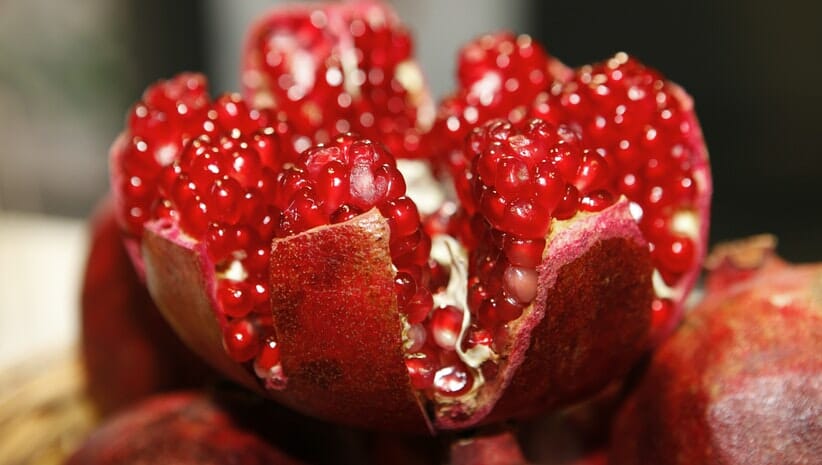
A healthy heart begins with insightful nutritional choices. This health continues with the inclusion of healthy heart habits such as calming the mind through meditation, opening our heart to love, and exercising. However, making wise decisions at the table is an important place to begin. If we do not make wise decisions on our plates, the benefits of these other practices are harder to fulfill.
The X Factor of Phytonutrients
Plants utilize the energy from the sun and through extraordinary processes, create the vital nutrients that support the metabolic needs of our body. In addition to the major classes of nutrients (including fats, carbohydrates, and proteins), plants contain the X factor known as phytonutrients. These chemical compounds provide the bright colors of fruits and vegetables. They also offer clues as to their beneficial functions. Here are five foods whose phytonutrient content makes them healthy heart powerhouses.
Pomegranate for a Healthy Heart
The bright red phytonutrients in pomegranates provide this fruit with a similar color to oxygenated blood. Many studies have been conducted on the cardiovascular benefits of pomegranates and a 2014 review in Advanced Biomedical Research found that it can help prevent high blood pressure, high cholesterol and inflammation (Zarfeshany, 2014). For best results, eat the fresh pulp with seeds as the seeds contain fibers and healthy fats; watch out for added sugars found in processed juices.
Kale and Dark Leafy Greens
With their low calorie count and packed nutrient profile, kale and other leafy greens are nature’s gift. Elements found in kale have been shown to favorably influence cholesterol profiles and high blood pressure in a study published in Biomedical and Environmental Sciences (Kim, 2008). For some, the raw leaves may be hard to digest; this can be solved by massaging kale with lemon and olive oil or by cooking kale and other greens with ginger, mustard seeds, or black pepper.
Whole Oats and a Healthy Heart
Whole oats have been identified by the FDA as a cholesterol-lowering food. Incorporating whole oats daily is a good plan according to a 2014 review in the British Journal of Nutrition (Thies, 2014). Oats contain the soluble fiber beta glucan. A review of studies published in the American Journal of Epidemiology has found that dietary fiber is correlated with lower risk of health issues (Yang, 2015).
One Ayurvedic recommendation for a hot breakfast is congee, or warm cooked grain. Soaked and slow-cooked whole oats with spices such as ginger and cinnamon and soaked dried fruit are full of fiber and support the day ahead. Oats are surprisingly high in protein (more by dry weight than egg whites). Therefore, oats offer a rich plant-based protein that includes an array of other essential nutrients.
Legumes
Evidence has emerged that higher consumption of red meat in women has been linked to cardiovascular disease. Some of this evidence can be found in a study published in the Archives of Internal Medicine (Pan, 2012). Through time, we have learned that plant-based protein interventions are effective in lowering plasma cholesterol concentrations (Ferdowsian, 2009). From an Ayurvedic perspective, legumes such as red lentils or mung beans are among the easiest to digest.
Rich in fiber, legumes also provide food for the essential bacteria in our gut, our microbiome. Soaking, sprouting, and slow-cooking legumes with cumin, coriander, fennel, and ginger can decrease the digestive concerns experienced by some people when eating beans.
There is a Reason to Season
Many cultures around the world have used spice blends for added flavor to meals. Each spice has a diverse spectrum of active phytonutrients that have complementary and overlapping actions. For example, the addition of spices such as ginger, cinnamon, black pepper, turmeric, and/or coriander assists in preserving heart function. This is written about in a study published in Current Cardiology Reviews (Vasanthi, 2010). Studies have even shown an inverse correlation between garlic consumption and progression of cardiovascular disease. One example is published in the Journal of Nutrition (Rahman, 2006).
The Synergistic Effects of Food
To protect your heart on a long-term basis, a good general rule is to ensure that your plate is half-filled with fresh fruits and vegetables. And while no one food is a magic potion, each bite has a synergistic effect with all your other dietary and lifestyle choices to create the foundation for a healthy heart. The average heart beats over 2.5 billion times throughout the course of our lives. And through wise decisions, we can give this dear organ the resources to perform its loving task optimally.
Dr Siri Chand Khalsa MD MS trained in internal medicine and has an ongoing interest in nutrition and Ayurveda. She has a primary care practice in Phoenix and writes additionally for her blog: luminousfoods.com.
